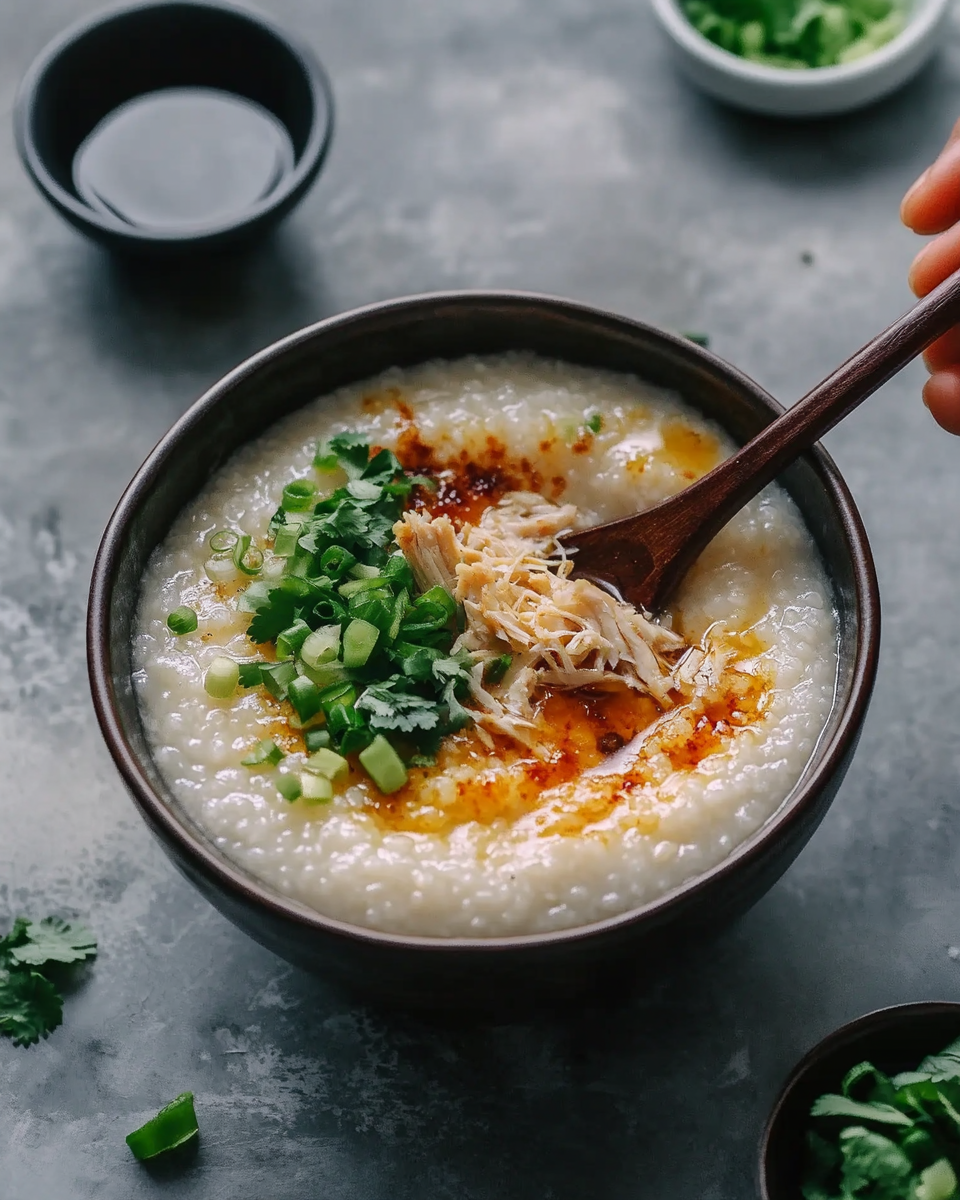Congee is a comforting and versatile Asian rice porridge that’s perfect for breakfast, light meals, or when you need something gentle on the stomach. Made by simmering rice in plenty of water or broth until it breaks down into a creamy texture, congee can be enjoyed plain or with a variety of savory toppings like shredded chicken, scallions, ginger, soy sauce, and more. It’s easy to make, nourishing, and customizable to your taste.
Full Recipe:
Ingredients
-
1 cup jasmine rice (or other short-grain rice)
-
8 cups water or chicken broth (adjust for desired consistency)
-
1 teaspoon salt (optional)
-
Optional toppings: shredded cooked chicken, sliced scallions, minced ginger, soy sauce, fried garlic, sesame oil, chopped cilantro, boiled eggs, pickled vegetables
Directions
-
Rinse the rice: Rinse the rice under cold water until the water runs clear to remove excess starch.
-
Cook the congee: In a large pot, combine the rinsed rice and water or broth. Bring to a boil over high heat.
-
Simmer: Reduce heat to low and simmer uncovered, stirring occasionally to prevent sticking. Cook for about 1 to 1.5 hours, or until the rice breaks down and the mixture becomes creamy. Add more water or broth if needed to reach your preferred consistency.
-
Season: Add salt to taste.
-
Serve: Ladle the congee into bowls and top with your choice of garnishes such as shredded chicken, scallions, ginger, soy sauce, or any preferred toppings.
Nutritional Information (per serving, plain congee)
-
Calories: ~150 kcal
-
Carbohydrates: 33 g
-
Protein: 3 g
-
Fat: 0.5 g
-
Fiber: 1 g
-
Sodium: 10 mg (without added salt or broth)
The Simplicity of Preparation
One of congee’s greatest strengths is its ease of preparation. Starting with basic ingredients—just rice and water or broth—it requires minimal culinary skills and equipment. The process begins with rinsing the rice thoroughly to remove excess starch, which helps achieve the desired silky texture without becoming overly sticky or gummy.
Simmering the rice on low heat for an extended period allows the grains to fully break down, transforming the pot into a creamy, porridge-like consistency. The long cooking time requires some patience but little active effort, as occasional stirring is the only task needed to prevent sticking and ensure even cooking. Adjusting the water or broth quantity allows for customization in thickness, from thick and hearty to thin and soupy, catering to personal preferences. Its creamy, smooth texture results from slowly simmering rice in ample water or broth until the grains break down and meld into a luscious porridge. This humble dish’s adaptability is unmatched—it can be enjoyed plain for a minimalist, easy-to-digest meal or dressed up with a variety of savory toppings to suit any palate.
Whether served in the early morning or late at night, congee’s appeal lies in its delicate flavor, comforting warmth, and versatility. It’s often considered a go-to for soothing an upset stomach or providing nourishment when appetite is low, making it a staple in many households across Asia.
Nutritional Benefits and Gentle Nourishment
Congee’s nutritional profile is simple but valuable, especially when made plain or with broth. It provides a moderate amount of carbohydrates, which serve as a gentle energy source, and a small amount of protein and fiber. The low fat content and mild flavor make it an ideal food during recovery from illness or digestive distress.
The dish’s warmth and softness aid in hydration and comfort, soothing the digestive tract while delivering essential nutrients without overwhelming the system. For those looking to enhance its nutritional value, adding protein-rich toppings like shredded chicken or boiled eggs boosts both flavor and satiety. Fresh herbs and aromatics such as ginger, scallions, and cilantro contribute antioxidants and vitamins, enriching the meal further.
Customizable Toppings for Flavor and Texture
One of the joys of congee lies in its versatility. While the base remains mild and creamy, toppings allow for endless personalization. Popular savory additions include shredded cooked chicken, which adds protein and heartiness; sliced scallions and minced ginger for freshness and a slight zing; soy sauce for umami depth; and fried garlic or sesame oil for aromatic richness.
Other toppings like chopped cilantro bring brightness, while boiled eggs add a creamy, rich texture. Pickled vegetables introduce a tangy contrast that cuts through the porridge’s mildness, creating a balanced and interesting flavor profile. This flexibility ensures congee can be a simple, light meal or a more complex and satisfying dish depending on the occasion.
Cultural Significance and Popularity
Congee holds a special place in many Asian cuisines, including Chinese, Korean, Japanese, Thai, and Vietnamese traditions, often considered a comfort food passed down through generations. It is commonly served at breakfast or as a healing food during illness due to its digestibility and soothing properties.
Its cultural significance extends beyond nourishment, embodying hospitality and care, frequently prepared for family members during times of need. The ease with which it can be customized also reflects regional preferences and ingredient availability, making congee a truly universal dish within Asian culinary landscapes.
Serving Suggestions
Congee is traditionally served hot, fresh from the pot, often accompanied by small side dishes or pickles to complement its mildness. It pairs well with simple steamed vegetables, salted duck eggs, or fermented tofu to introduce contrasting flavors and textures.
For a complete meal, try topping congee with a mix of protein, fresh herbs, and a dash of soy sauce or chili oil to elevate the experience. This balance of textures—from silky porridge to crunchy or chewy garnishes—makes each spoonful comforting yet exciting.
Conclusion
Congee is more than just rice porridge—it is a comforting, adaptable, and nourishing dish that offers warmth and simplicity in every bowl. Its gentle texture and mild flavor make it perfect for any time of day, particularly when you need something soothing and easy on the stomach.
The beauty of congee lies in its versatility: a blank canvas ready to be transformed with a variety of savory toppings to suit your taste and dietary needs. Its cultural roots and longstanding role as a healing food highlight its enduring appeal across Asia and beyond.
Adding this recipe to your website will provide readers with an accessible, wholesome dish that can be enjoyed in countless ways. Congee’s balance of nutrition, comfort, and customization makes it a timeless favorite worth incorporating into any culinary collection.

